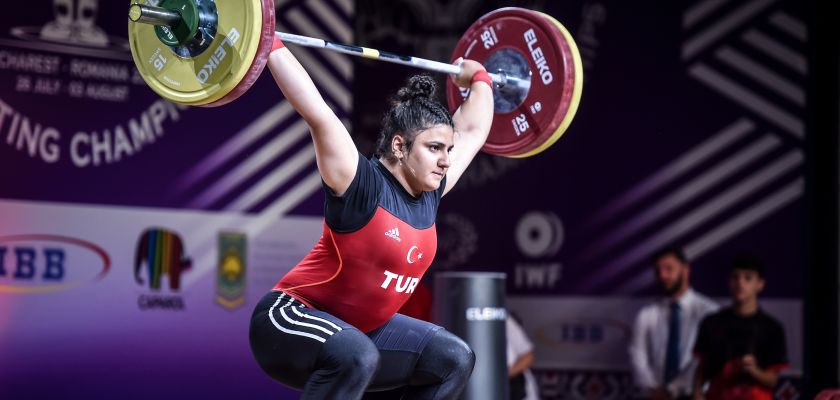For those who don’t know much about the sport, it may seem that all you have to do is arrive, lift the weight and you’re a champion. But the truth is that the weightlifting rules are very detailed and involve the execution of a series of compulsory movements.
Also known as weightlifting, weightlifting is an exciting sport that tests athletes’ strength and technique.
For this, the official competitions are governed by a set of rules, which must be complied with in order to guarantee the athlete’s continuation in the competition.
Join our free WhatsApp community and receive daily tips, news and trivia on more than 50 sports! Click here to join.
Weightlifting rules manual
The weightlifting rules relate to aspects such as:
- Respect for the weight limits of each category;
- Maximum number of lifting attempts;
- Techniques for each stage of the competition;
- Perfect execution of all stages of the start and throw;
- Judging by the judges;
- Summation for final score
We’ll explain each one in more detail below.
Weight categories
Athletes compete in specific weight categories, determined by the International Weightlifting Federation (IWF), to ensure fair competition.
At the Olympic Games in Paris, weightlifting will be divided into two disciplines: men’s and women’s, with different weight categories in each.
For men, the categories will be divided as follows:
- up to 61 kg;
- up to 73 kg;
- up to 89 kg;
- up to 102 kg;
- +102 kg
For women, the categories will be:
- up to 49 kg;
- up to 59 kg;
- up to 71 kg;
- up to 81 kg;
- +81 kg.
In each category, the winners of the gold, silver and bronze medals are elected.
It’s worth noting that to ensure compliance with this weightlifting rule, athletes are weighed before the competition.
Number of attempts
One of the most important weightlifting rules is the number of attempts.
Each athlete has three chances for each movement (snatch and throw), and the best mark is added together to determine the total lifted.
Athletes have a time limit for each movement, usually around one minute.
Execution technique for each stage of the competition
Weightlifting events are divided into two stages: the snatch and the throw.
We have a special article describing each of these movements and you can check them out in detail at “All about weightlifting: it takes a lot more than strength!”.
But to make your life even easier, here’s a quick video so you can understand the details of these “two competitions”: snatch and throw.
Among the rules of the snatch, for example, you have to lift the bar with the weight from the ground to above your head, executing a single movement without pause, without supporting your body.
The throw, on the other hand, is performed in two parts. In the first, the athlete lifts the weight to shoulder height and then raises it above the head and stabilizes the body.
In short, the lifts must be performed according to specific criteria for each technique, as determined by the IWF.
This includes achieving a stable position after each lift.
Judging by the referees
The referees evaluate each lift and decide whether it was valid or not, based on the established technique and execution criteria.
If two or more referees consider a lift invalid, it is annulled.
In addition, the athlete must release the weight only after the referee’s release, which activates a “down” signal.
Scoring
Each athlete’s final score is the sum of the weights successfully lifted in the throw and the throw.
In the event of a tie in the final score, the athlete with the lowest body weight is the winner.
Other weightlifting rules that are important to know include:
- Athletes may not wear any kind of assistance equipment, such as compression garments.
- Athletes use a bar with discs of different weights and a belt to stabilize the lumbar spine.
- Lifters generally compete in order of body weight, from smallest to largest.
The rules of weightlifting guarantee the safety and quality of the sport. By understanding the rules, spectators can better appreciate competitions and athletes can prepare more effectively to achieve success.
Weightlifting disciplines
In addition to weightlifting with Olympic rules like the ones we’ve presented, there are two other modalities among the best known: Paralympic weightlifting and Powerlifting.
The Paralympic weightlifting is adapted for athletes with physical disabilities and has different categories depending on the type of disability.
Among the categories are men and women with lower limb disabilities and cerebral palsies.
These athletes perform a supine movement, lying on a bench and, as in the Olympic discipline, each competitor has three attempts.
Check out below the compilation of weightlifts made by the Rio 2016 Olympics team with competitors in the sport.
Powerlifting is a discipline focused on maximum strength, with three events: squat, bench press and deadlift.
10 greatest Olympic weightlifters of all time
- Pyrros Dimas (Greece): 4 Olympic appearances and 3 gold medals
- Halil Mutlu (Turkey): 3 Olympic participations and 3 gold medals
- Naim Suleymanoglu (Turkey): 4 Olympic appearances, 3 gold medals and 1 silver medal
- Hossein Rezazadeh (Iran): 4 Olympic appearances and 2 gold medals
- Paul Anderson (USA): 1 Olympic participation and 1 gold medal
- Waldemar Baszanowski (Poland): 3 Olympic appearances and 2 gold medals
- Liu Chunhong (China): 2 Olympic appearances and 2 gold medals
- Leonid Zhabotynsky (ex Soviet Union): 3 Olympic participations, 1 gold medal and 1 silver medal
- Zhou Lulu (China): 2 Olympic participations, 1 gold medal and 1 silver medal
- Charles Vinci (USA): 3 Olympic participations, 1 gold medal and 1 silver medal
To continue learning about the greatest athletes of the Olympic Games, check out our exclusive article: “Olympic record medalists: who they are, countries, sports and medals”.
Join our free WhatsApp community and receive daily tips, news and trivia on more than 50 sports! Click here to join.



